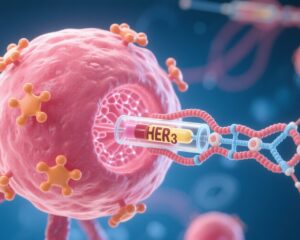Highlight
This article discusses exploratory circulating tumor DNA (ctDNA) analyses from the phase 3 SONIA trial. It reveals that pretreatment ctDNA levels can stratify patients with advanced estrogen receptor-positive (ER+), HER2-negative breast cancer who derive significant progression-free survival benefit from early incorporation of CDK4/6 inhibitors in first-line endocrine therapy. This contrasts with patients having low ctDNA levels who may not benefit from early CDK4/6 inhibitor use, advocating for a biomarker-driven therapeutic approach.
Study Background and Disease Burden
Advanced ER-positive, HER2-negative breast cancer remains a clinical challenge due to disease heterogeneity and development of endocrine resistance. CDK4/6 inhibitors (palbociclib, ribociclib, abemaciclib) combined with endocrine therapy have significantly improved progression-free survival (PFS) and overall survival (OS) in this setting. However, the optimal timing to initiate CDK4/6 inhibitors—whether during first- or second-line endocrine therapy—has been debated, given considerations of toxicity, cost, and quality of life. Previous trials showed mixed results regarding survival benefits with early use, and the SONIA phase 3 trial specifically addressed this question using PFS after two lines of therapy (PFS2) as the primary endpoint but found no significant difference at the cohort level.
Circulating tumor DNA has emerged as a minimally invasive biomarker reflecting tumor burden, molecular alterations, and dynamics during therapy. Leveraging ctDNA analysis to personalize the timing of CDK4/6 inhibitor therapy could optimize outcomes and reduce unnecessary treatment exposure.
Study Design
The SONIA trial was an open-label, randomized phase 3 study involving 511 postmenopausal women with advanced ER+/HER2− breast cancer. Patients were randomized to receive CDK4/6 inhibitors plus aromatase inhibitor (AI) as first-line treatment versus AI alone followed by CDK4/6 inhibitor combined with fulvestrant in second-line setting upon progression.
An exploratory biomarker analysis was prospectively prespecified to investigate whether baseline ctDNA levels can identify patients benefitting differentially from the timing of CDK4/6 inhibitor therapy. Cell-free DNA was extracted from plasma collected before first-line treatment from 409 patients. The modified fast aneuploidy screening test-sequencing system (mFAST-SeqS) was used to calculate genome-wide aneuploidy scores as a surrogate for ctDNA levels. Patients were categorized into ctDNA-high (aneuploidy score ≥5) and ctDNA-low (aneuploidy score <5) groups.
Primary analyses of progression-free survival after two lines of treatment (PFS2) and progression-free survival after one line of treatment (PFS1) were conducted within these ctDNA subgroups using Cox proportional hazards models to compare the early versus deferred CDK4/6 inhibitor strategies.
Key Findings
Among 409 patients with ctDNA data, 141 (34.5%) had high genome-wide aneuploidy scores indicating higher baseline tumor DNA levels.
In the ctDNA-high subgroup, first-line CDK4/6 inhibitor use significantly improved PFS2 compared to second-line use, with a hazard ratio (HR) of 0.58 (95% confidence interval [CI], 0.38–0.88). This implies a 42% reduction in risk of progression or death after two lines of therapy with early CDK4/6 inhibitor treatment for these patients.
Conversely, in the ctDNA-low subgroup, early CDK4/6 inhibitor use did not improve PFS2 compared to deferred therapy (HR 1.36; 95% CI, 0.95–1.96), suggesting no benefit and potentially even worse outcomes with early use in this subgroup.
The interaction test between treatment strategy and aneuploidy score for PFS2 was statistically significant (P=0.004), supporting ctDNA level as a predictive biomarker for timing of CDK4/6 inhibitor incorporation.
Results were consistent when analyzing PFS1. Safety, health-related quality of life, and cost-effectiveness data were reported in the main SONIA trial publication but were not significantly influenced by ctDNA stratification in this exploratory analysis.
Expert Commentary
This innovative ctDNA analysis provides compelling evidence that pretreatment tumor DNA burden can guide individualized therapeutic decisions in advanced ER+/HER2− breast cancer. Patients with high ctDNA likely harbor more aggressive or extensive disease and derive meaningful benefit from early CDK4/6 inhibition, while those with low ctDNA may safely defer CDK4/6 inhibitors to second-line without compromising overall clinical outcomes.
The mFAST-SeqS assay is a rapid and cost-effective tool, increasing feasibility of translating this biomarker into routine clinical practice. However, validation in independent cohorts and integration with other clinical and molecular features (e.g., ESR1 mutations, homology repair deficiency) will enhance precision further.
Potential limitations include the exploratory nature of this analysis and lack of predefined threshold consensus for aneuploidy scores in breast cancer. Differences in CDK4/6 inhibitor agents and patient characteristics could affect generalizability. Prospective biomarker-driven trials to confirm the predictive utility of ctDNA levels are warranted.
Conclusion
The exploratory ctDNA analysis from the SONIA phase 3 trial identifies circulating tumor DNA levels as a promising predictive biomarker for deciding early versus deferred CDK4/6 inhibitor therapy in advanced ER+/HER2− breast cancer. This biomarker-driven approach may optimize therapeutic benefit, minimize unnecessary toxicity, and improve cost-effectiveness by selecting patients most likely to benefit from early CDK4/6 inhibition based on baseline tumor DNA burden.
<pFurther prospective validation and integration of ctDNA metrics into clinical decision algorithms could mark a significant advance toward personalized management in this common and heterogeneous breast cancer subtype.
References
Jongbloed EM, Wortelboer N, de Weerd V, et al. Early versus deferred use of CDK4/6 inhibitors in advanced breast cancer: circulating tumor DNA analysis of a randomized phase 3 trial. Nat Med. 2025. doi:10.1038/s41591-025-03935-w.
Cardoso F, Senkus E, Costa A, et al. 4th ESO-ESMO International Consensus Guidelines for Advanced Breast Cancer (ABC 4). Ann Oncol. 2018;29(8):1634-1657.
Turner NC, Slamon DJ, Ro J, et al. Overall survival with palbociclib and fulvestrant in advanced breast cancer. N Engl J Med. 2018;379(20):1926-1936.
Miller TW, Rexer BN, Garrett JT, Arteaga CL. Mutations in the phosphatidylinositol 3-kinase pathway: role in tumor progression and therapeutic implications. Breast Cancer Res. 2011;13(6):224.



